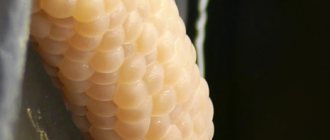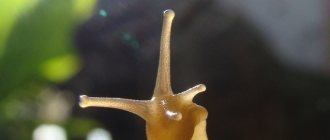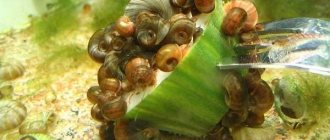09/28/2019Shellfish0
The beauties of Tilomelania from the Indonesian island with their unusual colors have long won the hearts of snail lovers. Active and mobile, Orange rabbits take root well and reproduce in an aquarium with a comfortable environment.
- 1 Description and natural habitat
- 2 Mr. Tail Recommends: Basics of Aquarium Keeping
- 3 Compatibility
- 4 Feeding
- 5 Breeding
Description
The Tilomelania snail (Rabbit Snail) is quite large in size. The length of the pointed conical shell of the mollusk ranges from 2 to 12 cm. The shell can be smooth or with needle-like spines in the form of curls.
The mollusk has several names:
- Darwin's snail,
- Orange snail Tilo,
- Orange head
- Fatal orange snail.
Despite the presence of the word “orange” in the name, the bodies of these snails can be yellow, cream, black with yellow or white spots. There are even specimens with black bodies and yellow tentacles.
The eyes of tilomelania are small and located under the tentacles. The color depends on the habitat.
Habitat
The homeland of tilomelania is the Indonesian island of Sulawesi. Shellfish are found in Lake Poso and the Malili River. They were brought to Europe by the Dutch, who colonized the island in the early 19th century. These snails are suitable for reservoirs with both rocky and muddy bottoms. Most tilomelania live at a depth of 1-2 m, but sometimes they are also found almost at the very bottom.
Keeping tilomelania at home
A small aquarium is suitable for these snails:
- The minimum length of the aquarium should be 60-80 cm.
- The volume of water for one individual should be at least 10-15 liters.
- temperature should be maintained at 27-30° C.
- Tilomelanias love space, so you shouldn’t keep a lot of plants .
- The water should be soft , with a pH value of 8.3-8.6 (at least 7.5). In an excessively hard water environment, thylomelanias become less active and may even go into hibernation. And if they are too soft, their shells are destroyed.
- Tylomelania need special soil - the bottom should be covered with plant leaves. The presence of snags is a must, a couple of large stones are desirable. This is both a decoration for the aquarium and a good hiding place for snails - they like to hide in the shadows. The base of the soil is sand; gravel is not suitable for thylomelanias.
- The aquarium must have good aeration - tilomelania need a large amount of oxygen. Be sure to regularly partially change the water.
Avoid introducing food and fertilizers containing copper into the aquarium. Copper is a strong toxin for snails. Copper sulfate is found in many industrial fish foods, so if snails live in the same aquarium with fish, you need to select food without this ingredient.
Behavior in the aquarium
After adaptation, the snails will begin to feed very quickly and greedily. You need to be prepared for this and feed them plenty.
Only old snails will stay in one place, without opening their shells, for several days, and then go explore the aquarium.
This behavior frightens and upsets aquarists, but there is no need to worry.
If the snail is inactive, scatter food around it, give it a piece of zucchini, and you will see it open its shell and go in search of food.
Judging by the behavior of snails taken from the natural environment, it is clear that they do not like bright light.
If they crawl out into a brightly lit space, they immediately retreat into dark corners. Therefore, the aquarium should have shelters or heavily planted areas.
If you decide to keep a separate aquarium with tilomelania, be careful with the types of snails you will keep in it.
Hybrids occur in nature, and it has been proven that they can also interbreed in an aquarium. It is unknown whether the offspring of such hybrids are fertile.
If keeping a clean line is important to everyone, then there should only be one type of tilomelania in the aquarium.
Nutrition
The tilomelania orange rabbit snail has a good appetite. These mollusks are constantly in search of food, since their natural habitat is poor in food. If you don't feed them enough in the aquarium, they will eat the aquarium plants. The only things they don't eat are moss and cladophora.
Tilomelanias feed on dry food and can eat fish that have died in the aquarium.
The diet of shellfish can include:
- defrosted shrimp,
- raw fish fillet and finely chopped fresh vegetables - cucumber, zucchini, white cabbage.
- They are fed several times a day - spirulina, special tablets that sink to the bottom when placed in water, granules and flakes for catfish, food for shrimp.
Food must fall to the bottom - in search of food, tylomelanias are capable of burrowing into the ground.
It is important to feed the snails with calcium supplements from time to time - it is needed for the normal condition of the shell.
Tilomelanias are a kind of aquarium orderlies; they eat up leftover food from fish, dead parts of underwater plants, biofilm and fish waste.
These mollusks need to be fed more than other inhabitants of the aquarium. The rule “it is better to underfeed” does not work with them.
Feeding and care
This interesting creature has an excellent appetite; it is constantly in search of food and, from hunger, can even eat algae. The only aquatic plants they will not like are moss and cladophora. These snails eat dry food well, and are also not averse to eating dead fish. The tilomelania menu may consist of the following products:
- shrimps;
- fish fillet;
- chopped vegetables: cucumbers, zucchini, white cabbage.
You can use ready-made food, but one that settles to the bottom and does not float on the surface. For example, spirulina, granules and flakes for catfish and shrimp are suitable. In order for the snail shell to fully develop, it is important to include calcium in the diet.
If tilomelania is kept together with other fish, then it will be able to eat food intended for fish, eat up their waste, and clean the aquarium of dead fragments of aquarium plants. That is, this snail may well serve as a biological filter in an artificial reservoir.
If a mollusk eats ready-made fish food, make sure that it does not contain copper sulfates, since this substance is poisonous to gastropods. Destructive copper can also be contained in fertilizers that some aquarists use to feed aquatic plants. Individuals are fed several times a day, and this is exactly the case when it is better to overfeed the pets than not to underfeed them. In search of food, the snail can burrow into the ground.
When caring for tilomelania, monitor the operation of the aeration system. These snails need plenty of oxygen. In addition, it is important to change the water of 1/3 of the aquarium volume every week.
Reproduction and lifespan
Tilomelania are heterosexual viviparous mollusks, although they have no obvious sexual differences. Females give birth to one baby every two months. The newborn snail is encased in a milky white shell, which the mother snail and baby eat together. Sometimes other snails help them so that the baby can free himself quickly and be able to move around. The length of newborn snails is from 0.28 cm to 1.75 cm. Tylomelania grow slowly - it takes them 8-9 months to reach a size of 7-8 cm.
The young animals behave very actively. The cubs quickly get used to the aquarium and move freely around it. You can find them anywhere:
- on glass walls,
- in the ground,
- on the stems and leaves of plants.
Tilomelanias have one feature - they can give birth to an unfertilized egg, that is, just a shell without an embryo inside. This phenomenon is called shock birth. They can occur when there is a sudden change in the composition of the water in the aquarium or when a newly acquired snail is placed in the aquarium. Shock birth can also happen to an embryo that has not fully developed - such babies may well survive.
In an aquarium, tilomelania reproduce with difficulty, especially if they are kept with fish. The lifespan of these snails ranges from 1 to 3 years.
Habits in aquarium conditions
Having adapted to a new place, tilomelania begin to eat a lot and greedily. When purchasing these mollusks, you should take this feature into account and provide more food in the first days. If the snail is young, it will immediately begin to actively explore its new home. Old individuals may not emerge from the shell at all for the first few days. To stir up a new clam, you need to scatter food around it, put a piece of cucumber or zucchini. Then he will emerge from the shell, sensing food.
If you take tilomelania from its natural environment and place it in an aquarium, it becomes clear that these snails do not like bright light. The pet will immediately begin to look for a darker corner. Tilomelania rarely crawl into a well-lit space; in the aquarium it is necessary to provide more shelters for them - snags and places with dense plants.
Tilomelania can interbreed with other species of snails. Therefore, if you want to keep purebred mollusks, you do not need to add snails of other breeds to them.
Hybrids are often found in the natural environment; whether they can produce offspring is unknown.
Thylomelania snail content orange rabbit
The giant orange Sulawesi rabbit snail (Tylomelania sp.) is one of the rarest snails in the aquarium hobby. They are also known as Elephant snails, their natural habitat is in Indonesia, and they are sometimes found in the United States. The name "Rabbit" probably comes from their rabbit-like faces and drooping antennae that resemble rabbit ears. However, the resemblance of tilomelania to an elephant is also immediately apparent from their wrinkled, rubbery skin and long muzzles. Needless to say, these snails are certainly unique in their appearance!
What animals can be kept next to tilomelania?
Tilomelania are completely peaceful creatures. If they are small, they can easily get along with them in the same aquarium:
- ampularia,
- coil snails,
- "devil's thorns"
- Melania and "Pokemon".
Together with tilomelania, you can keep neighbors in their biotope - Sulawesi shrimp; they feed on the mucus that tilomelania secrete.
But it is better to keep large individuals separately from other aquarium animals, small fish and shrimp.
It is also not recommended to keep fish - food competitors - together with tilomelania, so that the snails always have enough food. Shellfish should not be placed with large aggressive fish-predators. It is contraindicated to keep shellfish one at a time - there should be at least a couple of them in the aquarium.
It is interesting to observe tilomelania when a newcomer is introduced into an aquarium with already established individuals. Snails crawl towards each other to get to know each other through tactile contact. If this does not happen, then they need to be specially brought closer to each other so that their heads touch, then the process of mastering and getting used to will go much faster.
Lighting
It is necessary to create soft diffused lighting, the intensity of which will be about 0.3 W/l. This is due to the fact that Tylomelania are nocturnal. Even by their behavior, you can see how snails, as soon as they find themselves in a brightly lit space, immediately retreat to darkened places. And the lighting provided will be enough for you to watch your colorful snails throughout the day.
If there are plants in your aquarium for which such lighting will not be enough, we suggest making a compromise in which both will be happy: place grottoes and driftwood on the ground. Snails can hide here.
Infection of tilomelania with parasites and getting rid of them
Mollusks of this species are often carriers of parasites - small leeches. They can be observed on the snail's body with the naked eye. Parasites look like moving black dots. If you find leeches on a snail, it should be immediately quarantined. Otherwise, it will quickly infect all other inhabitants of the aquarium. There is no need to say goodbye to your pet - it can be cured.
As a remedy, you need to dissolve 0.5 teaspoon of salt in 250 ml of water at room temperature. An infected tilomelania snail is immersed in a bath of solution for 10 minutes. For leeches, salt is an irritant - once in a salty environment, they leave the host. The baths must be repeated until all the leeches leave the mollusk’s body.
There are known cases when tilomelania became almost tame and recognized the owner.
5 / 5 ( 1 voice )











